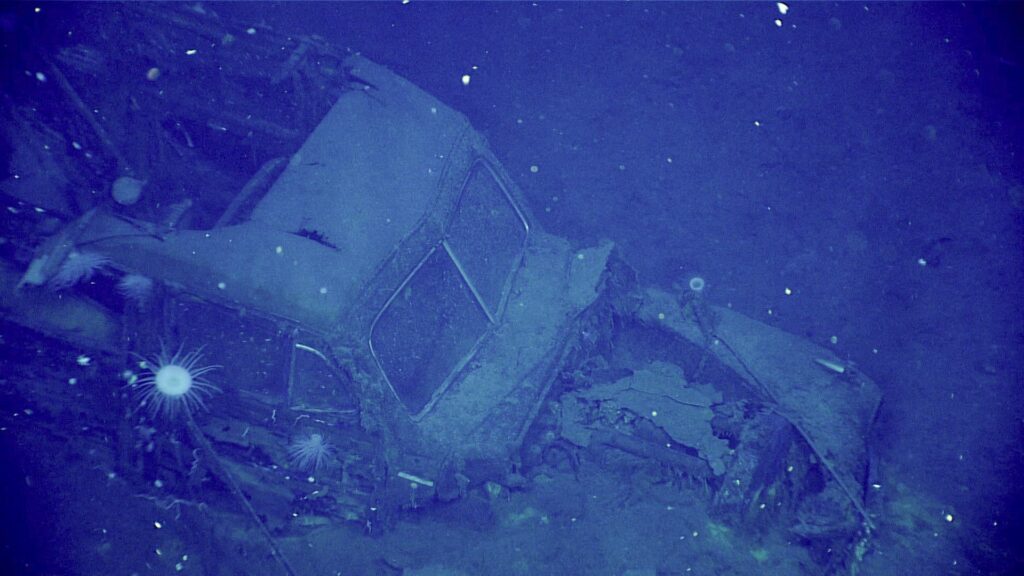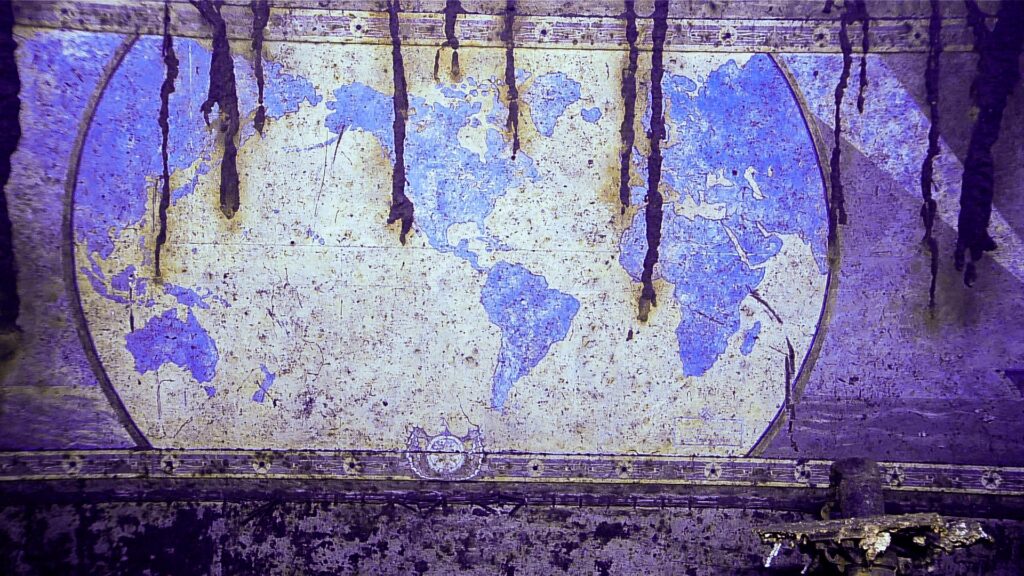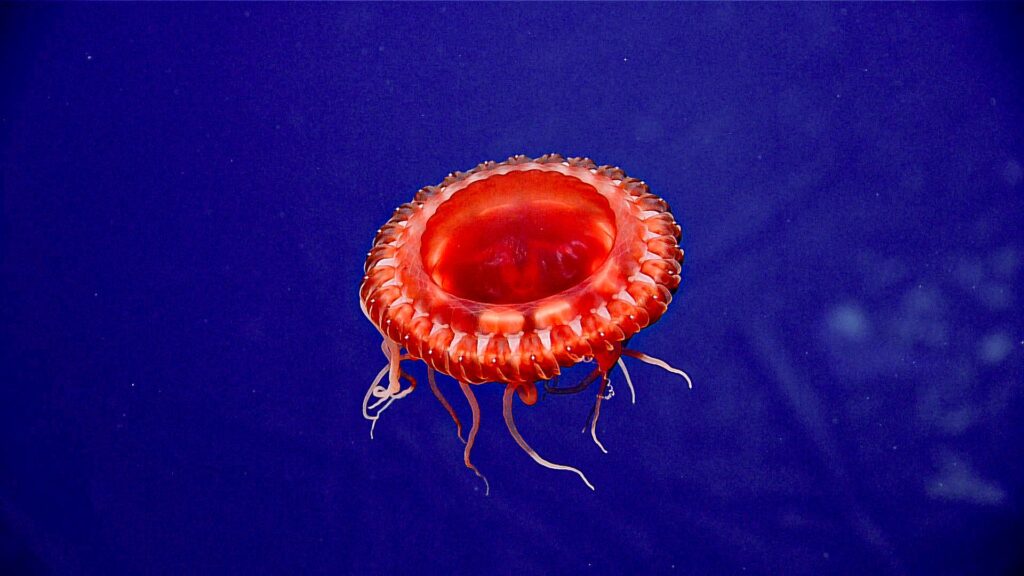
The World War II aircraft carrier USS Yorktown has been resting on the ocean floor about 1,000 northwest of Honolulu. It was torpedoed by Japan in the Battle of Midway on June 7, 1942. Researchers are taking their first look inside with remote cameras. (Image courtesy of NOAA Ocean Exploration, 2025 Beyond the Blue),
A genuine mystery is unfolding in the depths of the Pacific Ocean, where researchers exploring a sunken World War II aircraft carrier discovered some surprising cargo.
,
Instead of warbirds in the hangar on the USS Yorktown, which has been resting on the ocean floor since 1942, National Oceanic and Atmospheric Administration Ocean Exploration researchers found a fancy-for-the-times 1940-1941 Ford Super Deluxe “Woody.”
The researchers called it an “exciting find,” according to McClatchy News.
,
“It’s a car. That’s a car. That is a full car,” a surprised researcher exclaimed when the shiny hubcaps on the tires came into view of the remotely operated camera during the April 19 exploration.
(Story continues below photo)

, A 1940-1941 Ford Super Deluxe “Woody” was found in the wreck of the USS Yorktown. (Image courtesy of NOAA Ocean Exploration, 2025 Beyond the Blue)
The 809-foot vessel was torpedoed by Japanese forces during the Battle of Midway. Crew members jettisoned guns, aircraft, and other heavy cargo into the ocean in a frantic effort to keep the vessel afloat before they were ordered to abandon ship, according to NOAA Ocean Exploration.
“Yorktown’s salvage crew worked tirelessly to jettison anti-aircraft guns and aircraft to reduce its list (after the torpedo strike), but did they leave the car, something they could roll off the side?” NOAA officials said in an email to McClatchy News. “Perhaps the car belonged to someone important on the ship or to the fleet: the captain or admiral.”
,
One good guess: The USS Yorktown was Rear Admiral Frank Fletcher’s flagship, so it seemed likely the vehicle was his flag car.
It’s a little fancier than the standard Ford Super Deluxe cars favored by the Navy at the time, not as luxurious as a Lincoln, but still a vehicle of distinction.
,
“Evidently staff cars of the Ford Super Deluxe model were common with the Navy and Army ashore; however, as of yet, they haven’t been able to find a ‘Woody’ in service for staff officers, so that is potentially unique for this ship,” NOAA said.
“Here’s an open request to all your automobile vehicle folks out there,” one researcher said in live feed of the exploration. “I’m sure you are being attentive to this and you understand what you are looking at. Please post on this. It really helps.”
Another theory is the car was brought aboard at Pearl Harbor for repairs after it was damaged in the Battle of the Coral Sea in May 1942, according to McClatchy News.
Whatever the reason, “hangar space on carriers was (and still is) extremely valuable,” one person commented on a Reddit thread about the discovery. “Having a car occupying space would be remarkable.”
The ship had hangar space for 90 aircraft, including fighters, dive bombers and torpedo bombers, as well as observation aircraft, that is planes typically used for tactical purposes.
,
The car wasn’t the only surprise researchers found. Inside one of the vessel’s elevator shafts was a hand-painted, 42-by-12-foot mural called “A Chart of the Cruises of the USS Yorktown,” a world map showing all the places the ship had sailed since it was commissioned in 1936.
The artwork had been partially shown in historic photographs taken before the ship was sunk.
“Its motifs showcase the pride that Yorktown’s sailors had for their ship, the global scale of Yorktown’s activities, and the strategic role that the ship played in defending the United States,” NOAA said.
(Story continues below photo)

A map of the USS Yorktown’s voyages showcases the pride sailors had in their ship, according to NOAA. (Image courtesy of NOAA Ocean Exploration, 2025 Beyond the Blue.)
The wreck of the USS Yorktown was discovered in 1998 by Robert Ballard, the famed explorer who discovered the RMS Titanic; the National Geographic Society; and the U.S. Navy.
,
The team has visited the ship wreckage twice as part of a 28-day expedition to explore and map the deep water regions of the Papahānaumokuākea Marine National Monument, a more than 582,578-square-mile region in the Northwestern Hawaiian Islands. The ship was discovered about three miles below the surface about 1,000 miles northwest of Honolulu.
The monument is significant not only for the aircraft carrier resting on the ocean floor but also for its rich marine biodiversity, the cultural importance of Native Hawaiians, and its role as a protected sanctuary for various species, including coral, marine mammals, the endangered Hawaiian monk seal, the threatened green sea turtle and endangered leatherback and hawksbill sea turtles.
(Story continues below photo)

While exploring the wreck of USS Yorktown during a recent dive of the Papahānaumokuākea ROV and Mapping expedition, NOAA explorers encountered a colorful red jellyfish, which may be a new species. (Image courtesy of NOAA Ocean Exploration, 2025 Beyond the Blue)
The sunken ship, known to carry as many as 3,300 sailors, is the final resting place for the 14(1 officers and crewmen who died when the ship sank on June 7, 1942. It is a protected sunken military craft managed by the Naval History and Heritage Command.
The wreck of the USS Yorktown was designated a “Site of Extraordinary Character” by the U.S. Navy in 2023 in recognition of its importance in the Battle of Midway, a turning point in the Pacific Theater that shifted the strategic advantage from the Japanese to the Americans.

, The USS Yorktown is shown anchored in Hampton Roads, Virginia, in 1937. (Image courtesy of Naval History and Heritage Command),Get more local news delivered straight to your inbox.







